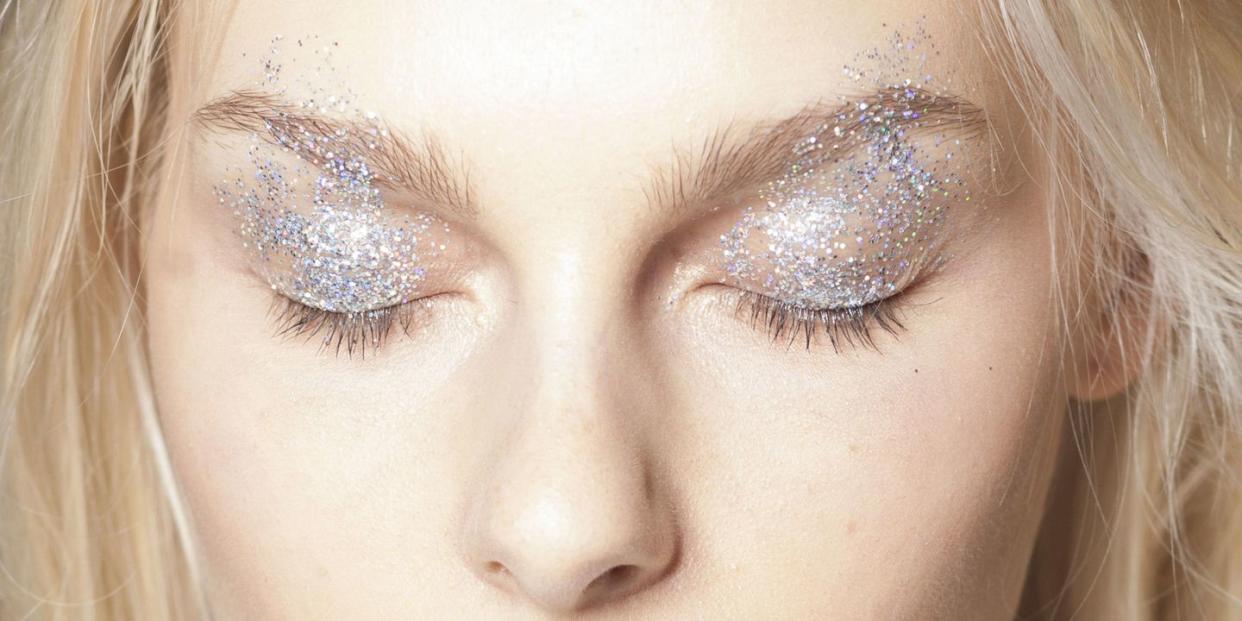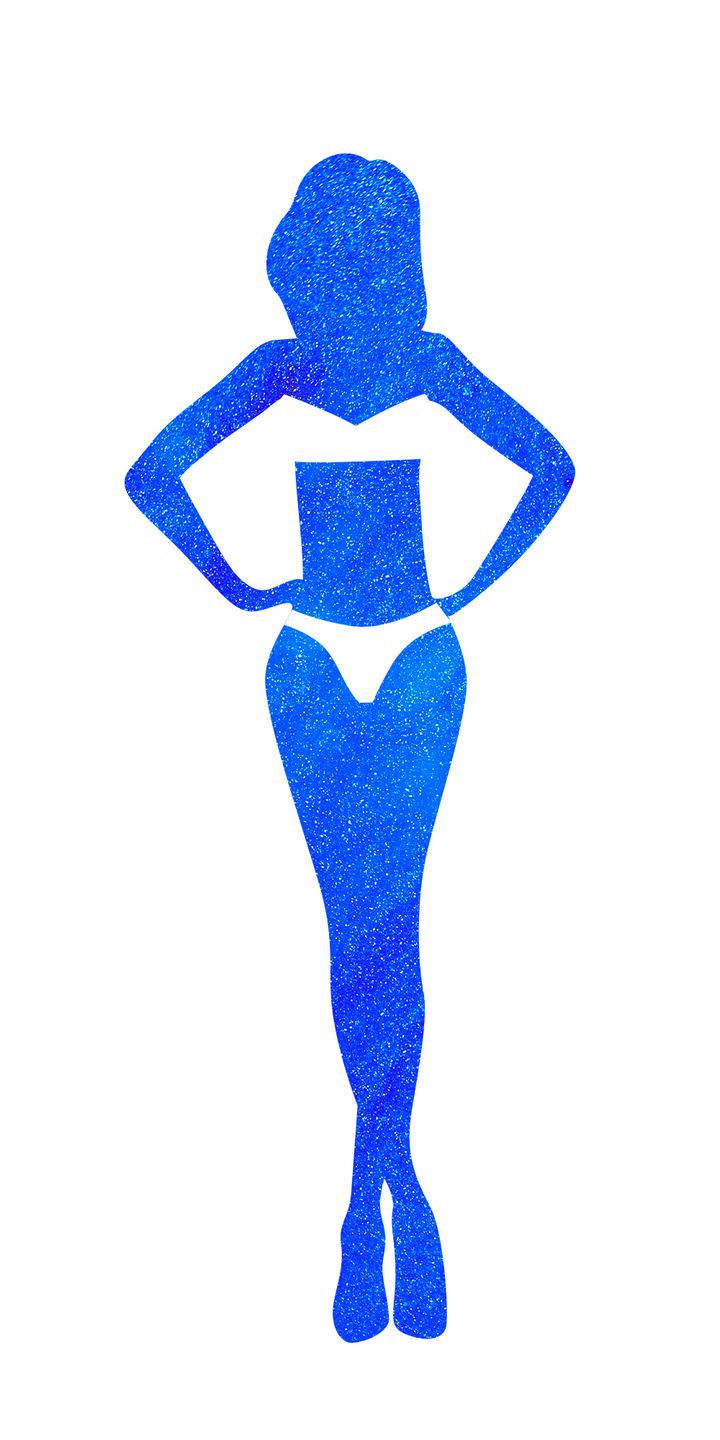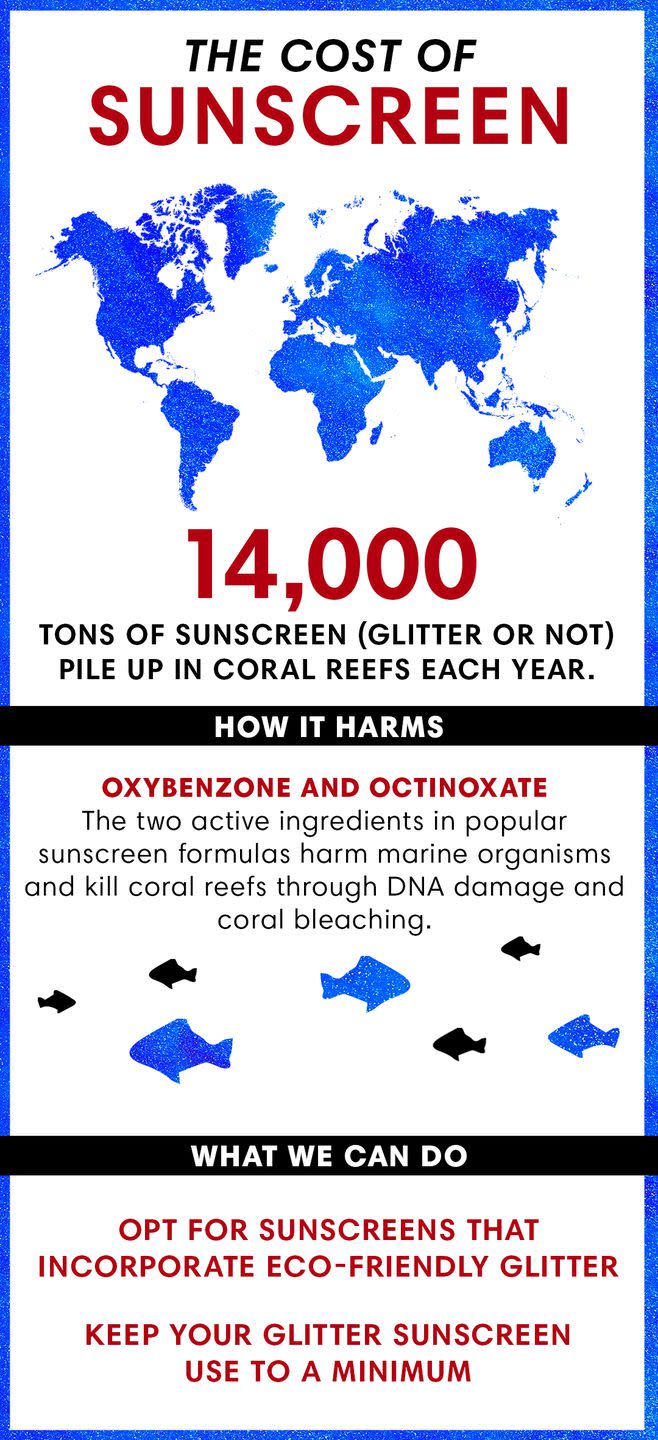What You Need To Know Before Buying Glitter SPF

Glitter has serious staying power, and we’re not just talking about how you’re still cleaning it off your bathroom counter months after New Year’s Eve. Shimmer's been a regular in beauty products for ages, so much so that you can find it everywhere: in eye makeup, on nails, and, more recently, patted onto lips. That’s why the inevitable invention of glitter sunscreen shouldn’t exactly be a shocker.
It sounds ridiculously extra, but the goal of glitter sunscreen is to make sun protection feel like less of a chore. 'Sun safety is super important-and making it fun is just a bonus,' says Meredith Madsen, founder of Sunshine & Glitter, which offers three variations of glitter-packed sunscreen. 'We are driven by making quality products that have a sense of joy to them.' This selling point seems to be working-glitter sunscreen is this summer's biggest beauty trend. The brand Unicorn Snot, best known for their holographic glitter gels, sold out of their first batch of glitter sunscreen in less than three hours. 'Anticipation was unlike anything we've seen before,' says a representative from the brand.

Sunscreen, while necessary, isn't exactly Instagram-fodder, so it was probably due for a makeover anyway. Still, while the always-sparkly, sometimes-holographic addition may give SPFs some much-needed love from influencers and glitter fans alike, it may come with a downside. Unlike other visually-driven beauty products like rainbow highlighter, sunscreen has the far more serious responsibility of protecting skin from cancer.
The good news here is that the FDA regulates sunscreens like an over-the-counter drug-meaning the safety standards are way higher than those for any cosmetic. And all of the brands on the market at the moment do indeed have FDA approval. 'The proof is in the SPF testing,' says Steven Wang, MD, a dermatologist in New Jersey and chair of The Skin Cancer Foundation’s Photobiology Committee. 'They still have to undergo the typical sunscreen testing and get the broad-spectrum status.' That means the risk of the glitter reflecting UV radiation back onto your skin instead of away from it, theoretically increasing damage, is minimal.
There may even be an upside: Someone typically opposed to sunscreen-such as a child-may find new appeal in it. 'If you have a kid who loves glitter and wants to put it all over, that individual is getting extra protection,' says Wang. And on a larger scale, people who wrote off SPF as unnecessary may be more inclined to use a glittery version. (Just make sure the bottle is labeled 'broad-spectrum SPF' and includes a box denoting active, skin-protecting ingredients.)
Glitterally Gorgeous! @ishboutique #sunshineandglitter #beachgypsy #wanderlust #beachglam #repost
A post shared by Sunshine & Glitter (@officialsunshineglitter) on Jun 2, 2018 at 1:21pm PDT
But there’s still room for error, particularly in the application. 'If sunscreen doesn’t have very concentrated glitter, it would theoretically encourage people to use more so they get more glitter,' says Wang. 'But if you have a product that has a high density of glitter, you might use less of it and get far less protection.' It’s difficult to ascertain how each glitter sunscreen stacks up in this respect, because the concentration and density varies according to the product.
Then there’s the issue of the glitter itself, which can hold serious consequences for the environment. Because, sure, it’s no microbeads, but swimming with or washing off the glitter introduces more into the water supply. 'I hate to hate on glitter, since it seems like harmless fun, but some of it will inevitably wash or rub off and persist in the environment,' says Sonya Lunder, a senior analyst at Environmental Working Group.
This can have especially dire consequences for wildlife. 'This plastic pollution is really bad because it will be swallowed by fish, sea turtles, whales, et cetera and end up in their guts,' explains Craig A. Downs, PhD, the executive director of Haereticus Environmental Laboratory, a nonprofit dedicated to studying and protecting natural environments. 'That could either outright kill the organism that swallowed it or cause a chronic intestinal inflammation-which in the wild is as good as dead.' It can also harm coral reefs, adds Downs, as well as increase turbidity, a measure of visibility and light penetration in water that’s used to assess its quality.
The products look less like harmless fun once you factor in the environmental risk of the sunscreen itself. Studies show that oxybenzone and octinoxate, two active ingredients in popular sunscreen formulas (including a few with glitter), harm marine organisms and kill coral reefs through DNA damage and coral bleaching-and that's no small matter, as researchers estimate 14,000 tons of sunscreen pile up in coral reefs each year. The risk to ocean life is so dire that Hawaii recently banned the sale of any sunscreen containing both ingredients.

Some glitter sunscreens do incorporate eco-friendly glitter. 'One sunscreen, Beach Gypsy, is the only sunscreen available with biodegradable glitter currently out there,' says Madsen. 'Our other products use standard cosmetic, BPA-free plastic glitter.' Meanwhile, the glitter in Justice’s Pink Glitter Sunscreen Spray and Lotion are made of natural materials, which presumably minimise any environmental harm. 'The glitter from the spray is mica and titanium dioxide, which come from the Earth and are ground up to varying particles sizes to give colour effects,' says a Justice spokesperson.
Unicorn Snot’s signature holographic effect-while unique-poses an additional challenge. 'Biodegradable glitter isn't currently available in holographic or iridescent varieties,' explains the rep from Unicorn Snot. 'However, we’re working with a chemical engineering firm in the UK that is trying to develop exactly such a product.' It’s still too early to estimate when it’ll be available, though.
A post shared by Ashley Elizabeth Hair Makeup (@aehmartistry) on May 19, 2018 at 4:55pm PDT
Until that happens, it may be best to keep your glitter sunscreen use to a minimum. Save it for special occasions, like an outdoor wedding or music festival, and layer it as you would a highlighter over traditional sunscreen to ensure you’re getting full coverage and curtailing environmental damage. And anyway, much like glitter anywhere else, less is more.
You Might Also Like


